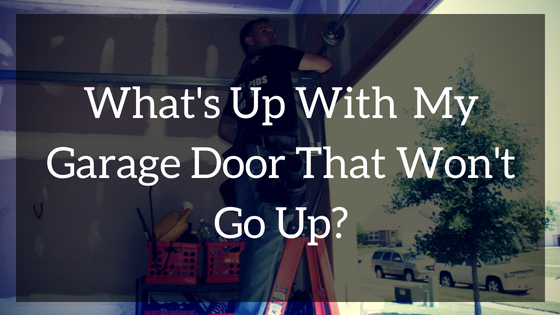Your Garage Door Won’t Go Up?

Almost all garage doors are raised and lowered with the power of an electric motor and assistance from heavy-duty springs. But what happens when one of the springs break, are becoming worn, or need to be adjusted? What can you do? We’ll look at the life of a garage door spring and what to regularly keep an eye on.
Garage doors utilize two types of springs, torsion springs, and extension springs. Torsion springs are mounted on the wall directly above a garage door when it is in the down position and work based on energy created from a twisting motion. Extension springs are located above the upper horizontal tracks on both sides of a garage door.
Torsion Springs
Each day torsion springs endure extreme amounts of stress, yet they can last 4-10 years depending on how often the door is used. 10,000 cycles is a typical life of a torsion spring! Inevitably, these springs that are critical to the door’s operation will wear out and may even break.
If a Torsion Spring Breaks:
Garage doors can be very heavy so avoid injury by leaving it as it is. Don’t try to lift it. Aside from possibly injuring yourself, you also risk burning the garage door opener’s motor out when lifting the door.
Contact a garage door professional right away. Replacing garage door components, especially torsion springs, requires specialized tools and techniques to ensure they are installed properly.
(Torsion) Spring Maintenance
There are a few ways to tell if your springs need to be adjusted or replaced, and it’s easy enough to handle on your own. One of the most common adjustments that need to be made is re-balancing. Torsion springs can become unbalanced for a variety of reasons, which can result in uneven wear on parts, premature breaking, and mechanical failure.
Garage door professionals recommend customers have their torsion springs re-balanced within two years of being installed. Also, it’s important to note springs that have been installed in cold-weather months need to be adjusted before the two-year mark. Annual lubrication of the torsion springs are also recommended (a rust inhibitor lubricant is best. Not WD 40).
Extension Springs
Garage door extension springs are mounted over each horizontal track of the garage door and counterbalance the weight of the door by providing resistance through the stretching of the springs. Since no adjustment can be made to extension springs, they must be replaced when they’ve worn out or have broken. The following points are simple ways to tell if it’s time to replace your extension springs.
Replace the springs when:
- You can visibly tell the spring is broken, cracked, chipped, or has any damage that can cause catastrophic failure.
- The springs have become overstretched, and gaps have formed between the rings.
- The garage door lowers too quickly and has difficulty raising.
- The motor is obviously laboring to raise the door.
- The garage door is crooked when it’s going up or down.
Testing Garage Door Balance
- The door should stay in the upright position when released from the opener. (Some movement is okay, but it shouldn’t fall below the horizontal track)
- Position the door halfway up. It should stay in place.
Failing these two tests means the door is out of balance and requires an adjustment.
The most important takeaway from the information above is to call a garage door professional when you think there’s an issue with your system. Garage door springs can be very dangerous, even deadly, if installed by a non-professional.
